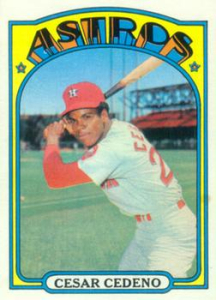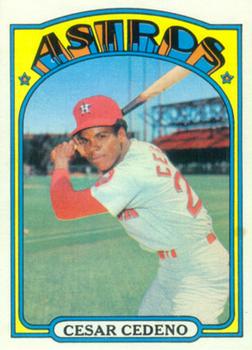August 2, 1972: César Cedeño becomes first Astros player to hit for the cycle
 “I just want to get hits.”1 With this sentiment, 21-year-old César Cedeño paced the Houston Astros to a 10-1 thumping of the first-place Cincinnati Reds on August 2, 1972, hitting for the cycle in front of an Astrodome crowd of 31,838.
“I just want to get hits.”1 With this sentiment, 21-year-old César Cedeño paced the Houston Astros to a 10-1 thumping of the first-place Cincinnati Reds on August 2, 1972, hitting for the cycle in front of an Astrodome crowd of 31,838.
Cedeño was in his third big-league season. He had finished fourth in National League Rookie of the Year balloting in 1970. Cedeño led the NL with 40 doubles in 1971, and his 81 runs batted in paced the Astros. In 1972 there was speculation that “he would be the game’s next superstar.”2
The last time these two teams met (a four-game series played in Cincinnati in late June), they split the series and each team took turns see-sawing in and out of first place. Houston then fell into a skid in July, and Cincinnati solidified its hold on the top spot in the NL West standings.
August began with the second-place Astros hosting the Reds for a two-game series. Cincy won the first game, 3-1, with Joe Morgan’s two-run homer in the fifth being the difference.
Morgan, in his first season with the Reds after nine seasons with Houston, was leading the NL in several categories, including runs scored. On November 29, 1971, the Astros had traded him, with Ed Armbrister, Jack Billingham, César Gerónimo, and Denis Menke, for Tommy Helms, Lee May, and Jimmy Stewart. When told that he was a “new, revived ballplayer in a Cincinnati uniform,” the 28-year-old Morgan replied, “I don’t think the trade from Houston has done anything at all for me except put me on a better team.”3
Cincinnati started Gary Nolan in the series’ second game. The right-hander entered with the National League’s best ERA (1.71). He had won his last five decisions and was in search of his 14th win of the season. Nolan had won his very first start in the majors against Houston in April 1967, and he was 10-4 against the Astros for his career coming into this game.4
Don Wilson started for the home team. He spent his entire nine-season career with the Astros and despite a lifetime 9-10 record against Cincinnati before this game, Wilson considered the Reds “his favorite competitors.”5 His ERA was twice Nolan’s (3.41).
Each club had a baserunner through the first two innings, but both pitchers kept the game scoreless. Then, in the bottom of the third inning, Houston’s Helms led off with a single and moved to second on Wilson’s sacrifice and to third on Roger Metzger’s groundout.
Cedeño, who had doubled but was stranded in the first, swung at a 1-and-1 pitch and “unloaded into the left-field seats”6 for his 15th home run of the season. Back-to-back doubles by Jim Wynn and May accounted for a third Houston run.
The score remained 3-0 until the top of the fifth. Wilson struck out Gerónimo but Menke, who entered with a .222 average, launched his fifth home run, over the wall in left-center field.
The Astros answered in their next turn at bat. Metzger tripled and scored on Cedeño’s single. That gave Cedeño three hits, a single, double, and home run, through the first five innings. With Wynn batting, Cedeño was caught trying to steal second base. It was the 11th time he had been caught stealing, against 33 steals.7 After Wynn flied to left for the second out, May walked and Bob Watson singled. That signaled an end to Nolan’s time on the mound. Jim McGlothlin was called in from the bullpen.
The first batter McGlothlin faced was Johnny Edwards, whose infield single loaded the bases. Doug Rader’s single to center drove in both May and Watson. The Astros now led, 6-1. Both runners moved up on catcher Johnny Bench’s passed ball. McGlothlin intentionally walked Helms in order to face Wilson. Houston had batted around, but Cincinnati’s strategy worked, as Wilson hit a comebacker to McGlothlin for the third out.
Wilson faced the minimum in the sixth, and the Astros were hitting again. Metzger singled and was forced at second on Cedeño’s grounder to short. Wynn’s double plated Cedeño with Houston’s seventh run.
The Reds managed to get a runner to second in each of the next two innings, but Wilson stranded them both. He had allowed just five hits through eight innings.
Metzger and Cedeño combined for another score in the bottom of the eighth inning. Pedro Borbón was now on the mound for Cincinnati. Cedeño “added the crowning glory to his night,”8 following Metzger’s single with a cycle-completing triple. He scored on Wynn’s sacrifice fly.
May followed with his 22nd home run of the season, completing the scoring. Geronimo singled in the ninth and took second on a wild pitch, but Wilson retired the other Reds batters with two strikeouts and a fly out. The Astros won, 10-1.
Cedeño’s fifth three-bagger of the season gave him four runs batted in for the game. He had also scored three runs. This rare feat was just the second cycle ever hit at the Astrodome, both in 1972: Dave Kingman of the San Francisco Giants had hit for the cycle on April 16.9 Cedeño finished the game with a 4-for-5 performance, raising his league-leading batting average to .353. Cedeño batted .473 against Cincinnati pitching that season, with seven doubles, three homers and 12 RBIs. Four years later, on August 9, 1976, Cedeño hit for the cycle again, against the St. Louis Cardinals at Busch Stadium.
Wilson pitched a complete game, earning his seventh victory and lowering his ERA to 3.24. The Astros batters collected 16 hits off the trio of Reds pitchers. Nolan took his third loss. Even with scoring 10 runs, Houston had left nine men on base. The Astros had “trimmed the Reds”10 for the first time in the Astrodome in 1972, possibly bolstering their pennant dreams. Houston moved to within five games of the division-leading Reds. Despite winning 18 of 28 games in August, the Astros lost ground in the standings and finished the season tied with the Los Angeles Dodgers for second place in the NL West, 10½ games behind Cincinnati, which defeated the Pittsburgh Pirates in the NLCS before falling to the Oakland A’s in the World Series.
In 1972 Cedeño’s 39 doubles again led the league. Both his .320 batting average and his .537 slugging percentage were fourth-best in the NL. He belted 22 home runs and drove in 82 runs. Cedeño finished sixth in the MVP race, was named an All-Star (his first of four selections) and won a Gold Glove Award (his first of five). After this historic game, John Mullen, Houston’s director of player personnel, called Cedeño the best player in the majors and told the press that “he wouldn’t trade him … not even for Johnny Bench.”11 From 1972 to 1977, Cedeño had a WAR of 36.3, third-best in the majors over that span.12
Cedeño was also being compared to other stars, such as Roberto Clemente, to which he replied, “I don’t want to be the second Clemente. I would rather be the first Cedeño.”13 Unfortunately, injuries (knee, ankles, finger ligaments) and his aggressive style of playing probably prevented him from election to the Hall of Fame.14
Cedeño claimed he was not trying to hit for the cycle. He told reporters, “When I got the third hit, [an] umpire asked me why I didn’t try for the cycle. When I get three hits, I just try for four. When I get four, I just try for five.”15 Cedeño added that earlier in the season, against the Dodgers and Padres, he had hit three home runs in four games. This led to wild swinging. “I said to myself, ‘I’ve got to go back to hitting the ball up the middle and get my mind off home runs.’”16 He just wanted to get hits.
Acknowledgments
This article was fact-checked by Bruce Slutsky and copy-edited by Len Levin.
Sources
In addition to the sources mentioned in the Notes, the author consulted Baseball-Reference.com, MLB.com, Retrosheet.org, and SABR.org.
https://www.baseball-reference.com/boxes/HOU/HOU197208020.shtml
https://www.retrosheet.org/boxesetc/1972/B08020HOU1972.htm
Notes
1 Associated Press, “Cedeno, Houston Belt Cincy, 10-1,” Piqua (Ohio) Daily Call, August 3, 1972: 14.
2 John DiFonzo, “César Cedeño,” SABR Biography Project, https://sabr.org/bioproj/person/cesar-cedeno/.
3 Harry Shattuck, “Morgan Hustling as Much as Before, but the Results Are So Much Better,” Houston Chronicle, August 2, 1972: 86.
4 Nolan finished his career with a 15-6 record against the Astros.
5 Matthew Clifford, “Don Wilson,” SABR Biography Project, https://sabr.org/bioproj/person/Don-Wilson/. Wilson finished his nine-season career with a 14-14 record against the Reds.
6 Bob Hertzel, “Cedeno ‘Re-Cycles’ Reds, 10-1,” Cincinnati Enquirer, August 3, 1972: 33.
7 Cedeño led the NL with 21 CS in 1972. For his career, he swiped 550 bases, but he was caught 179 times. As of the beginning of the 2023 season, this ranks 12th-most all-time.
8 Hertzel.
9 On April 16, 1972, San Francisco’s Dave Kingman collected his first four hits of the season, resulting in a cycle.
10 Associated Press, “Cedeno Does Everything in Astro Victory,” Fort Worth Star-Telegram, August 3, 1972: 59. The Astros went 6-11 against the Reds in 1972, winning only two games in the Astrodome. (The second time was on September 23.)
11 Hertzel.
12 From 1972 to 1977, the only NL players with higher WAR values were Joe Morgan (53.6) and Johnny Bench (37.4).
13 John Wilson, “Cesar Cedeno … The Next Super Star,” The Sporting News, August 19, 1972: 3.
14 DiFonzo, “César Cedeño,” SABR Biography Project.
15 “Cedeno Does Everything in Astro Victory.” This was Cedeño’s fourth (and last) game of 1972 in which he collected at least four hits.
16 John Wilson, “Cedeno Rides Cycle,” Houston Chronicle, August 3, 1972: 23-24.
Additional Stats
Houston Astros 10
Cincinnati Reds 1
Astrodome
Houston, TX
Box Score + PBP:
Corrections? Additions?
If you can help us improve this game story, contact us.


